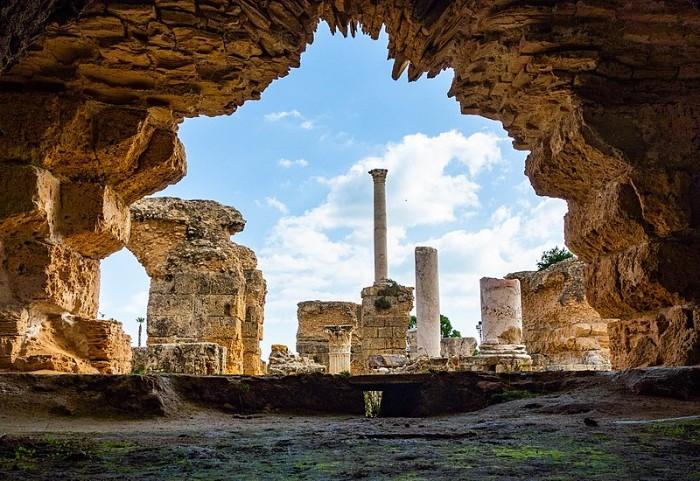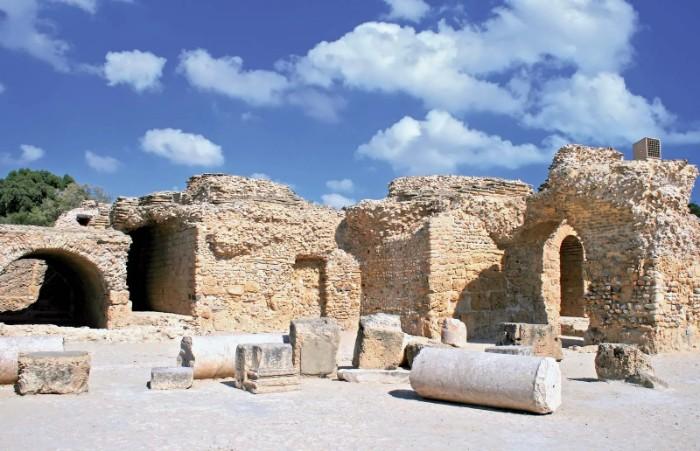As an explorer, you might be intrigued to discover the ancient ruins of the city known as Carthage. Located in modern-day Tunisia, this influential civilization was once a major power on the African and Mediterranean coasts, lending their influence over individuals from Africa to Europe for centuries.
Today, its majestic remains still stand proudly, carrying secrets of a bygone era waiting to be explored. In this guide, you will learn why these ruins are so significant today and how they can be accessed during your journey through history.
An Overview of Carthage’s Historical Significance and Rich Cultural Heritage

Carthage was one of the most powerful cities of its time and is thought to have been founded around 800 BC. It was a major hub for trading and commerce in the Mediterranean region and held strong diplomatic ties with other nations, including Rome.
The city was home to some of the world’s greatest minds and a rich cultural heritage. It was an important center of learning and scholarship, with various temples and shrines dotted around the ruins.
The site has been visited by many over the years, including ancient Greeks, who wrote extensively about their experiences there. As a result, it's also been mentioned in countless myths and legends.
Today, Carthage is recognized as a UNESCO World Heritage Site, and its ruins are a popular tourist attraction. The archaeological site includes sprawling remains of ancient walls, mosaics, and monuments, which can be accessed for exploration or admired from afar.
Citing Carthage’s ruins is an extraordinary journey through history that everyone should experience at least once. Visiting this ancient site will give you a deeper understanding of the region’s rich cultural heritage and historical significance. It is a truly unique opportunity to explore an unforgettable part of the world.
Touring the Ancient Ruins with a Personal Guide

Touring the ancient ruins of Carthage is a unique experience you will never forget. A personal guide can help make the experience even more special by providing valuable insights into the history and culture of this once-powerful civilization.
With their expertise, you can explore sites such as the Byrsa Citadel, where Hannibal was once stationed, and the Roman Baths, which offer a glimpse into people's daily life at the time. You can also visit other sites such as the Punic Wall, Tophet Cemetery, and Byrsa Acropolis—all offering a different perspective on this ancient city.
A personal guide will take you through each site in detail, explain its significance, and bring the stories and myths of Carthage to life. You can ask questions, take photographs, or enjoy the atmosphere of these incredible ruins.
With their help, you can explore a part of human history preserved for centuries and gain a deeper understanding of the people who lived there so long ago.
Exploring the Ancient City's Streets and Temples
Exploring the ancient city of Carthage is a unique opportunity to go back in time and experience the ruins firsthand. The city's streets, temples, and buildings are incredibly well-preserved – some dating back over 2,500 years.
As you wander through the cobbled pathways, it's easy to imagine how life may have been for its citizens all those years ago. While some of the city’s most famous landmarks have been destroyed over time, there's still plenty to discover - from the ancient theater to the Temple of Baal and the baths that remain in surprisingly good condition.
The ruins are also steeped in history, providing an insight into the city’s former power and influence. You can explore the ruins of Punic and Roman forts and numerous Carthaginian cities - each offering something unique.
The ancient ruins of Carthage are a must-see for any explorer looking to travel through time and discover one of the world's most historically significant sites.
Experiencing Local Life in Carthage Today
Carthage's ancient ruins are still a vibrant part of the city today, providing an important insight into local life and culture. On your travels through the area, take in the beautiful views of the Mediterranean Sea and explore the many attractions built around these impressive remains.
Visitors can experience a traditional market, bustling with vendors selling everything from handmade items to fresh produce, or enjoy local delicacies such as couscous and harissa at one of the many restaurants in town.
Plenty of shopping options exist if you’re looking for something more modern.
Be sure to visit some of the galleries showcasing local artwork or watch musical performances by talented musicians in courtyards around town.
Where to Stay During Your Visit and What to Pack
If you plan to explore the ancient ruins of Carthage, several accommodation options are available. Many visitors choose to stay in Tunis, the capital city located nearby. Here you can find various hotels, resorts, and hostels that cater to all your needs.
Alternatively, if you want something closer to the ruins, there are comfortable guesthouses and luxury resorts within easy reach of archaeological sites. It is also possible to camp close by if you prefer a more rustic experience.
No matter which option you choose, don’t forget your hat and sunscreen; Tunisia has a warm Mediterranean climate most of the year round! A good pair of walking shoes are also essential for exploring the many archaeological sites in the area.
Don’t forget your camera, too, so you can capture all the remarkable sights Carthage offers.Finally, it is a good idea to bring plenty of water and snacks for energy; many sites are quite sprawling and require some physical exertion to fully explore.
Safety Tips for Exploring the Ruins in Comfort and Security
- Before visiting the ruins, research the history of Carthage and understand all applicable safety guidelines for the area.
- Wear appropriate travel clothing, such as long sleeves, durable shoes, and a hat, to protect yourself from the elements.
- Stay on designated pathways throughout the ruins to help preserve their condition and prevent injury or damage while you explore them.
- Use sunscreen and insect repellent when necessary, especially when traveling in hot climates with many bugs.
- Make sure that you are aware of any local wildlife that may be present at the ruins before starting your journey.
- Keep important items such as IDs, money, and cell phones secured in a bag or pocket to prevent loss or theft while exploring the area.
- Travel with a partner to help ensure safety throughout the exploration process.
FAQs
What are the ancient ruins of Carthage?
Carthage was an ancient civilization that dominated the African and Mediterranean coasts for centuries. Its ruins are a collection of archaeological sites located in modern-day Tunisia. These remains symbolize this powerful city’s history, culture, and influence.
What makes the ruins significant?
The ruins of Carthage are a tribute to its legacy as an influential trading hub that connected Africa, Europe, and the Mediterranean coasts. It is estimated that over 1 million people lived in this ancient city at its height, and its artifacts are still preserved.
How can the ruins be accessed?
Visitors can explore the ancient ruins by booking a guided tour offered by local operators or visiting independently. Access is strictly limited to preserving these priceless sites, and all visitors must adhere to site rules.
Conclusion
Embarking on a journey to explore Carthage’s ancient ruins is an incredibly rewarding experience. The city has a rich cultural heritage and important historical significance, making it an unforgettable place to visit.
The right preparation and guidance can make your excursion safe and comfortable. You will create long-lasting memories of this vibrant city by researching the area thoroughly in advance, becoming well-versed in safety tips, booking a personal guide tour, and exploring local life today.




